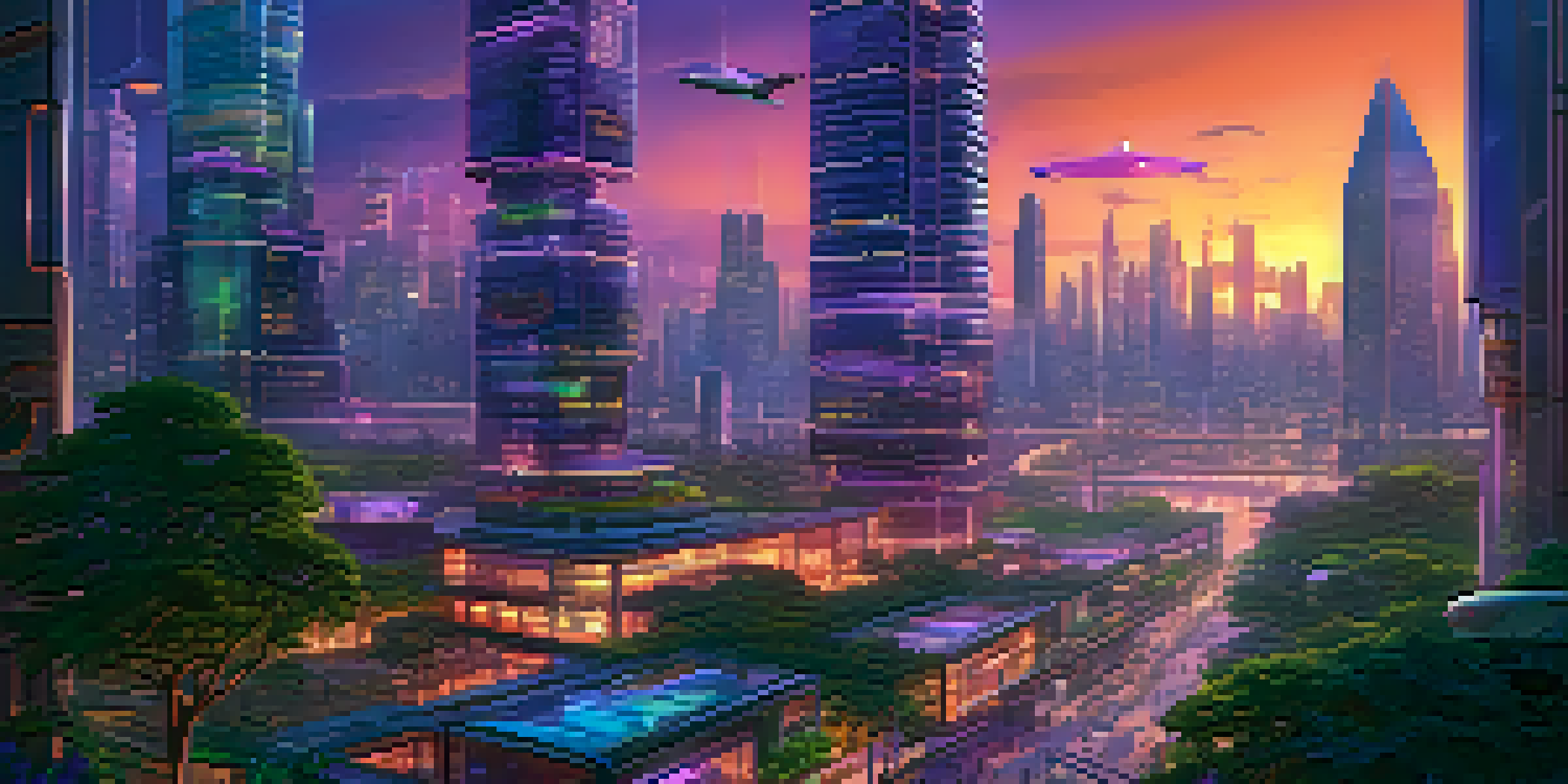Iconic Films That Revolutionized Visual Effects Techniques

Star Wars: Pioneering Space Visual Effects in Cinema
When 'Star Wars' released in 1977, it didn't just introduce audiences to a galaxy far, far away; it fundamentally changed how we approached visual effects. George Lucas and his team at Industrial Light & Magic (ILM) pioneered techniques like motion control photography, allowing for more complex and dynamic space battles. This innovation created a sense of realism that had been previously unattainable, making the thrilling dogfights feel both exhilarating and believable.
The technology we have in our hands today is a direct result of the creativity and innovation of the filmmakers who came before us.
The iconic TIE fighters zooming through space and the epic battles between the Rebel Alliance and the Empire were made possible due to these advancements. Audiences were not only entertained; they were captivated by the sheer scale of what was possible on screen. As a result, 'Star Wars' set a new benchmark in the industry, inspiring countless filmmakers and studios to explore the potential of visual effects.
To this day, the influence of 'Star Wars' can be seen in almost every blockbuster film. Its legacy continues as modern filmmakers build upon the foundation laid by Lucas and his team, pushing the boundaries of creativity and technology in storytelling.
Jurassic Park: Bringing Dinosaurs to Life with CGI
Released in 1993, 'Jurassic Park' revolutionized the use of computer-generated imagery (CGI) in film, bringing dinosaurs back to life in a way that thrilled audiences worldwide. Director Steven Spielberg combined practical effects with groundbreaking CGI, a blend that made the massive creatures feel tangible and real. The film's iconic T-Rex scene is a prime example of how effective this combination can be, leaving viewers on the edge of their seats.

The success of 'Jurassic Park' demonstrated the potential of CGI as a storytelling tool, encouraging other filmmakers to adopt it in their own projects. This shift towards digital effects paved the way for a new era in cinema, where the only limits were the imagination of the filmmakers. It also sparked discussions about the balance between practical and digital effects, a conversation that continues to this day.
Visual Effects Revolution in Film
Groundbreaking films like 'Star Wars' and 'Jurassic Park' pioneered innovative visual effects techniques that transformed how stories are told in cinema.
Following its release, the film not only set box office records but also changed the visual effects industry forever. The techniques developed for 'Jurassic Park' laid the groundwork for future franchises, proving that CGI could create not just stunning visuals but also emotionally resonant storytelling.
The Matrix: Innovating Action with Bullet Time
In 1999, 'The Matrix' introduced audiences to a revolutionary visual effect known as 'bullet time,' which allowed for dynamic slow-motion sequences that captured action like never before. This technique involved a series of cameras arranged in a semicircle, capturing multiple angles of a scene simultaneously. The result was a mesmerizing visual that made viewers feel as if they were part of the action, especially during the iconic dodging bullets scene.
The future is not something we enter. The future is something we create.
The film's use of visual effects not only enhanced the action sequences but also served a deeper narrative function, exploring themes of reality and perception. By blending philosophy with cutting-edge technology, 'The Matrix' challenged audiences to think critically about the world around them, making it a cultural phenomenon. This unique combination of thought-provoking storytelling and groundbreaking effects set a new standard in the sci-fi genre.
As a result, 'The Matrix' influenced a wave of films and video games that sought to replicate its innovative style. Its legacy can still be seen in modern action films, as filmmakers continue to experiment with visual effects to create immersive experiences for viewers.
Avatar: Redefining 3D and Motion Capture Techniques
James Cameron's 'Avatar,' released in 2009, brought the world of Pandora to life with stunning visuals and a groundbreaking approach to 3D and motion capture. The film utilized advanced motion capture technology to create lifelike characters, allowing actors to bring their performances into the digital realm seamlessly. This innovation not only enhanced the visual experience but also deepened the emotional connection between the audience and the characters.
The film's use of 3D was also revolutionary, as it went beyond simple gimmicks to create a fully immersive experience. Audiences felt as if they were part of the lush environments and thrilling action scenes, which was a game-changer for the film industry. 'Avatar' proved that 3D could be more than just a visual tool; it could enhance storytelling and emotional engagement.
Practical Effects vs. CGI Balance
'Mad Max: Fury Road' exemplifies the successful blend of practical effects and CGI, demonstrating that authenticity can enhance cinematic experiences.
With its groundbreaking visual effects, 'Avatar' became the highest-grossing film of all time, showcasing the power of innovation in cinema. The film's success prompted a resurgence in 3D filmmaking, inspiring filmmakers to explore new frontiers in visual storytelling.
Inception: Mastering Practical Effects and Visual Illusions
'Inception,' released in 2010, is a perfect example of how blending practical effects with visual illusions can create a captivating cinematic experience. Director Christopher Nolan employed real-world stunts and sets, such as the iconic rotating hallway fight scene, to ground the film in reality. This approach not only made the film visually stunning but also added a layer of authenticity to the mind-bending narrative.
The film's visual effects team, led by Paul Franklin, utilized innovative techniques to depict dreamscapes and gravity-defying moments. The seamless integration of these effects with practical elements allowed audiences to suspend disbelief and immerse themselves in the story. This careful balance between the real and the surreal became a hallmark of Nolan's filmmaking style.
Through its inventive use of visual effects, 'Inception' challenged traditional storytelling conventions, pushing the boundaries of what audiences could expect from a film. It demonstrated that visual effects could serve a narrative purpose, elevating not just the spectacle but also the emotional weight of the story.
Gravity: Pushing the Boundaries of Space Visuals
'Gravity,' directed by Alfonso Cuarón and released in 2013, took visual effects to new heights, literally. The film's depiction of space and zero gravity was achieved through a combination of CGI and innovative filming techniques, creating a breathtakingly realistic experience. Audiences felt as if they were floating alongside Sandra Bullock and George Clooney, fully immersed in the dangers of space.
The meticulous attention to detail in 'Gravity' set a new standard for visual effects in film. The team used over 1,000 visual effects shots to create a seamless experience that kept viewers on the edge of their seats. This dedication to realism showcased the potential of modern technology to convey the vastness and isolation of space in a way that had never been done before.
Future Trends in Visual Effects
Emerging technologies like VR, AR, and AI are set to redefine visual storytelling, creating immersive experiences that challenge traditional filmmaking boundaries.
As a result, 'Gravity' not only won numerous awards for its visual effects but also sparked discussions about the future of filmmaking. The film proved that with the right combination of technology and artistry, filmmakers could create experiences that transport audiences to new worlds, reshaping the landscape of visual storytelling.
Mad Max: Fury Road: A Return to Practical Effects Mastery
In 2015, 'Mad Max: Fury Road' made waves in Hollywood by championing practical effects while still utilizing visual effects to enhance its chaotic action. Director George Miller prioritized real stunts and sets, with many of the film's jaw-dropping car chases and explosions being achieved through practical means. This commitment to authenticity not only made the film visually striking but also added a visceral quality that heightened the viewer's adrenaline.
The film did integrate CGI to create some of its more fantastical elements, but the reliance on practical effects set it apart from many contemporary action films. By blending both techniques, 'Mad Max: Fury Road' showcased how filmmakers could honor traditional methods while still embracing new technologies. The result was a film that felt raw and intense, pulling audiences into its post-apocalyptic world.

This film's success demonstrated that there is still a place for practical effects in an increasingly digital age. It inspired a new generation of filmmakers to explore the potential of combining practical stunts with visual effects, reminding us that sometimes, less can be more in the quest for cinematic excellence.
The Future of Visual Effects: Trends and Innovations
As we look to the future of visual effects in cinema, several trends and innovations are poised to shape the industry. Technologies like virtual reality (VR) and augmented reality (AR) are beginning to blur the lines between the viewer and the cinematic experience. Filmmakers are experimenting with these tools to create immersive environments that invite audiences to step inside the story.
Additionally, advancements in artificial intelligence (AI) are revolutionizing the way visual effects are created. AI can assist in generating complex scenes, automating tedious tasks, and even enhancing the realism of animations. As these technologies continue to evolve, we may see a new wave of storytelling that pushes the boundaries of creativity and imagination.
Ultimately, the future of visual effects is bright and full of possibilities. As filmmakers harness these innovations, we can expect to witness captivating experiences that challenge our perceptions and redefine what cinema can achieve. The iconic films that changed the game have paved the way for a new era of visual storytelling, and the best is yet to come.